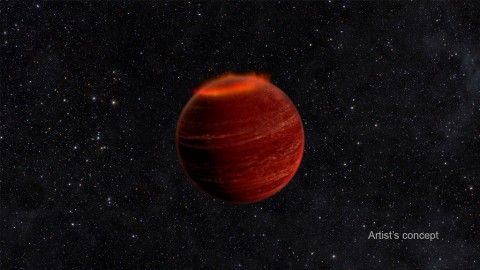Written by Elizabeth Landau
NASA’s Jet Propulsion Laboratory
 Pasadena, CA – Mysterious objects called brown dwarfs are sometimes called “failed stars.” They are too small to fuse hydrogen in their cores, the way most stars do, but also too large to be classified as planets.
Pasadena, CA – Mysterious objects called brown dwarfs are sometimes called “failed stars.” They are too small to fuse hydrogen in their cores, the way most stars do, but also too large to be classified as planets.
But a new study in the journal Nature suggests they succeed in creating powerful auroral displays, similar to the kind seen around the magnetic poles on Earth.
“This is a whole new manifestation of magnetic activity for that kind of object,” said Leon Harding, a technologist at NASA’s Jet Propulsion Laboratory, Pasadena, California, and co-author on the study.

“As the electrons spiral down toward the atmosphere, they produce radio emissions, and then when they hit the atmosphere, they excite hydrogen in a process that occurs at Earth and other planets,” said Gregg Hallinan, assistant professor of astronomy at the California Institute of Technology in Pasadena, who led the team. “We now know that this kind of auroral behavior is extending all the way from planets up to brown dwarfs.”
Brown dwarfs are generally cool, dim objects, but their auroras are about a million times more powerful than auroras on Earth, and if we could somehow see them, they’d be about a million times brighter, Hallinan said.
› Brown dwarfs are dim, cool objects that have star-like and planet-like qualities
› Researchers have discovered signatures of auroras at a brown dwarf called LSRJ1835+3259, which is 20 light-years away
Additionally, while green is the dominant color of earthly auroras, a vivid red color would stand out in a brown dwarf’s aurora because of the higher hydrogen content of the object’s atmosphere.
The foundation for this discovery began in the early 2000s, when astronomers began finding radio emissions from brown dwarfs. This was surprising because brown dwarfs do not generate large flares and charged-particle emissions the way the sun and other kinds of stars do. The cause of these radio emissions was a big question.
Hallinan discovered in 2006 that brown dwarfs can pulse at radio frequencies, too. This pulsing phenomenon is similar to what is seen from planets in our solar system that have auroras.
Harding, working as part of Hallinan’s group while pursuing his doctoral studies, found that there was also periodic variability in the optical wavelength of light coming from brown dwarfs that pulse at radio frequencies. He published these findings in the Astrophysical Journal.
Harding built an instrument called an optical high-speed photometer, which looks for changes in the light intensity of celestial objects, to examine this phenomenon.
The combination of results made scientists wonder: Could this variability in light from brown dwarfs be caused by auroras?
Given that there’s no stellar wind to create an aurora on a brown dwarf, researchers are unsure what is generating it on LSRJ1835+3259. An orbiting planet moving through the magnetosphere of the brown dwarf could be generating a current, but scientists will have to map the aurora to figure out its source.
The discovery reported in the July 30th issue of Nature could help scientists better understand how brown dwarfs generate magnetic fields. Additionally, brown dwarfs will help scientists study exoplanets, planets outside our solar system, as the atmosphere of cool brown dwarfs is similar to what astronomers expect to find at many exoplanets.
“It’s challenging to study the atmosphere of an exoplanet because there’s often a much brighter star nearby, whose light muddles observations. But we can look at the atmosphere of a brown dwarf without this difficulty,” Hallinan said.
Hallinan also hopes to measure the magnetic field of exoplanets using the newly built Owens Valley Long Wavelength Array, funded by Caltech, JPL, NASA and the National Science Foundation.
Caltech manages JPL for NASA.


